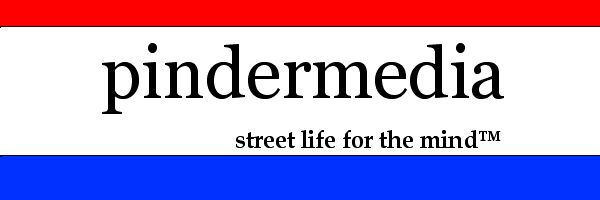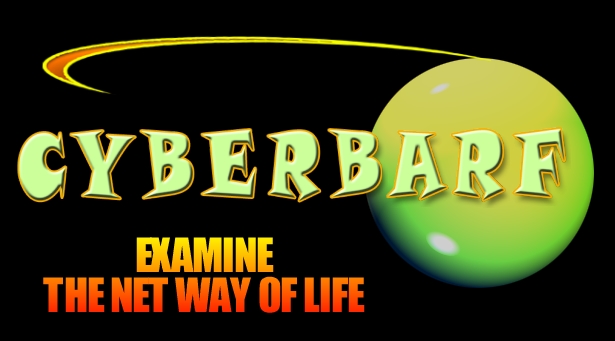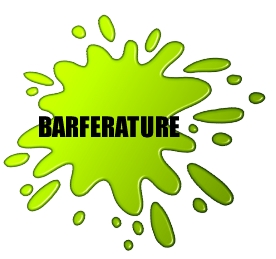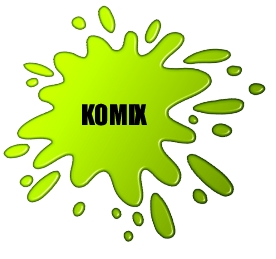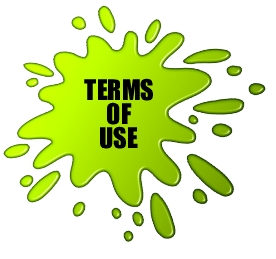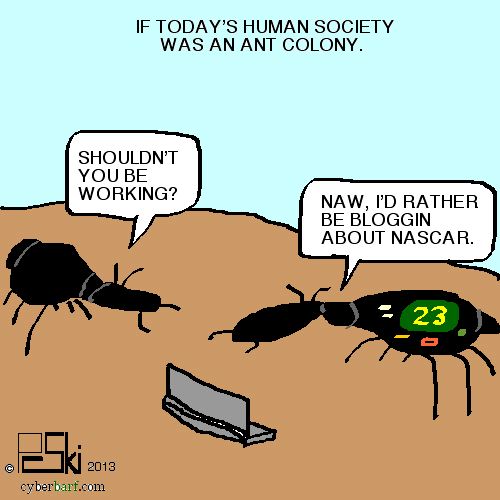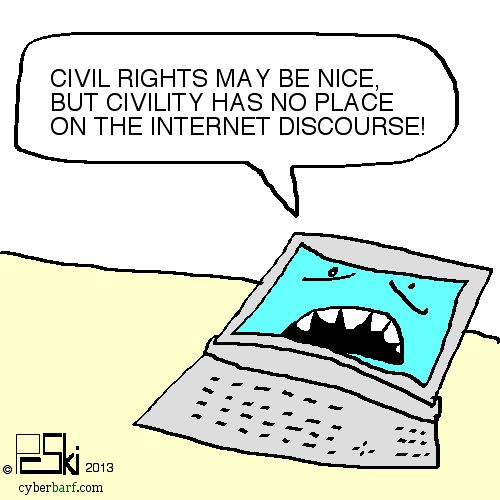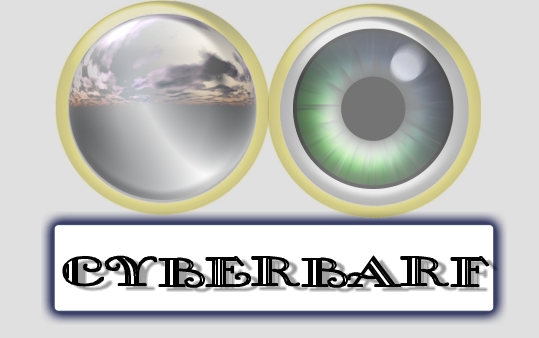|
FEBRUARY, 2013 IN THIS ISSUE:
SCREAMS SCREENS CATFISH INNOVATIONS II iTOONS NICE ENDING WHETHER REPORT NEW REAL NEWS KOMIX! SHOW HACK!
CYBERBARF T-SHIRTS, MUGS & MORE THANK YOU FOR YOUR SUPPORT! THANK YOUR FOR YOUR CONTINUED SUPPORT.
CYBERBARF
|
|
cyberbarf EXAMINE THE NET WAY OF LIFE For every ending, there is a new beginning: NEW REAL NEWS KOMIX! SHOW HACK! |
|
cyberbarf SCREAM SCREENS FUTURESPEAK The Vegas Consumer Electronics Show used to be a really big deal. Manufacturers brought out their newest and greatest electronic devices to pre-sell to distributors and to pre-hype to the general public. But following Apple's lead for self-contained media event promotions, most of the big consumer electronic firms now by-pass the trade show. This leaves the suppliers and after-market gadgeteers more space to find a willing voice in the media coverage. But the one clear trend from this year's show was screens. Screens are hot. Screens are the buzzwords. How big is too big? Is a four inch, four point five or five inch touch screen perfect for one's future smart phone? Or should we get to seven inch tablet sized smart phones (in essence merging iPads and iPhones into one super device)? That is the great screen territory debate. Further adding to the size is no object dream, another table size interactive coffee table debuted at the show. This one allows several people to interact on the screen at the same time. Think of it as an interactive card table, but with internet like web access and programs. Then there was the flexible screen technology. No one knows what application could be used for the thin film like screen that can be rolled up in to tubes, or turned like pages in a pamphlet. The concept of digital paper has been around for at least a decade, but this is not a digital medium but an actual touchscreen receiving information. What current device needs to have a computer screen wrapped around it? A toothbrush, a hammer, toilet paper roll, a can of soup? For what purpose - - - advertising, DIY program, reminder to reorder, or an e-book of recipes? Then we have the company promoting its new touchscreen bumpy keyboard. The gripe that some users have with flat touchscreens is that there is no tactile feel of a keyboard when one tries to impute characters in text or tweets. A company has devised a method of putting a gel under a thin touchscreen which will “bump up” rounded keys in the shape of a normal keyboard. Whether the bumpy keyboard will improve data input on a smartphone like device is yet to be seen. Television makers continue to expand the boundaries of a normal size television set. A dimension of 66 inches apparently is not enough. And built in 3D viewing without the polarized glasses is apparently the new milestone to lure technophiles back into the stores to buy the newest flat screens. But being the largest did not get the biggest buzz. Suppliers believe that another wave of small screens is on the way with the next generation of wrist watches. Instead of a clock face, the watch would be a small iPod nano type device with Wi-fi net access on its tiny control touch screen. Screens are also coming to your kitchen appliances. Manufacturers are looking to incorporate smart technologies into their refrigerators. Some believe that a combination bar code reader and door CPU could give a personal a real time inventory of their frig without even opening the door. It could also be used to program shopping lists when food is removed and not returned to the ice box. It seems that eliminating the thinking and list making of chores is another step in the smart technology applications. Smart cars were also on display. Now, the major automobile manufacturers do not want people to stop driving their vehicles. They just want to add more touch screens and Internet access features to existing models, allegedly to add to the driver's road experience. Others believe more screens on the dash is more of a distraction than a convenience. But to another extreme, the self-driving automobile has been given the green light in at least two American states. A driver must be sitting behind the wheel in case of a malfunction or loss of control, but it is car's CPU coordinating with car censors, cameras, mapping and GPS software is considered the future of transportation. cyberbarf CATFISH CULTURE It is still hard to believe that a star Notre Dame football player, Manti Te'o, was caught up in a huge Internet hoax. As the story goes, Te'o had a relationship with a woman who said she was a Stanford student. As the relationship progressed, the woman said she was hurt in a car accident, then developed cancer and died just as the Notre Dame championship season began. Te'o was allegedly heartbroken and dedicated his play to his deceased girlfriend.
It became a scandal when the university began its own investigation after Te'o told the athletic department. It became a scandal when the university held an emotional press conference denouncing the prank. Those in the Midwest know about the ND PR machine. It is mythology generator. The university took personal offensive that one of their star players were the victim in a prank. It took the position of elevating the situation to a national news story. It was using its arrogant posture of being an elite school to try to spin the situation to its sympathetic favor. Notre Dame had hyped Te'o as a Heisman trophy candidate from the beginning of the season. He could become the first pure defensive player to win the best college football player award. ND is all about champions and awards. During this fateful season, Te'o's personal adversities are played up in the national press, concluding with a national sports magazine cover story, which dealt with his dead girlfriend details. The story did generate a good amount of sympathy and name recognition for Te'o. He would become a Heisman finalist. He would earn All-American honors. He would be listed in the Top Ten on early NFL mock draft boards, including one writer deeming him a potential number one draft choice. As a result, Te'o celebrity was rising, and so were the millions in potential NFL salary and endorsement deals. As one GM said, you try to draft a college player who would be the face of your franchise, to enhance the team's brand. Well, once the hoax hit the main stream press, Te'o's draft stock began to decline in direct proportion to the name recognition he was achieving in the non-sports general public. He was played as the victim, but he kept his side of the story quiet for a long time. That led to suspicion. Was he part of the hoax from the very beginning? We may never know the motivations of the participants. We may never know the true story. It really should not matter in the end. No apparent laws were broken. The Internet is filled with exaggerations, lies, frauds, omissions and danger. There will always people out in the world who will prey on the weak or naive. Catfishing is just another cruel, juvenile game that is being played, and now probably copied over and over again, in the social media.
cyberbarf INNOVATION II ESSAY The History Channel/Popular Mechanics put together a program about the 101 most important or transformative gadgets in the history of mankind. Like all list stories, it is subject to personal opinion and WTH? reactions. Like last month's essay, the program's subjectivity is the hue and cry of any debate on the credibility of the subject matter. What is a gadget? Isn't a gadget also an invention? To recap, the show's top of human inventions were: Number five: the transistor. The show indicated that there are 11 billion transistors per person on the planet today. It continues to revolutionize the areas of electronics and engineering. Number four: the steam engine. To harass the power of steam was man's ability to harness the power of nature at an industrial scale. It fundamentally changed how man traveled, how he worked, and where he lived. Number three: the light bulb. The show recognized that Thomas Edison did not invent the light bulb, but improved it with filament technology to make it work better. As a result, the development of power companies and distribution grids changed mankind in a fundamental way: it made us into nocturnal creatures. Number two: the printing press. When the process of putting ink on a plate filled with movable type to press lasting impressions on a sheet of paper, it created a permanent source of communication and knowledge that could spread ideas, concepts and revolution throughout the world. One could now document history as it happened; lest not to repeat it in the future. Number one: the wheel. The show indicated that the wheel, a round object that turns on an axis, was incorporated into 35 of the list's 101 inventions. The wheel allowed man to move 40 times more weight than dragging an object. NOW, what is the definition of a GADGET? A gadget is defined as any small mechanical contrivance or device, especially something relatively useless or superfluous. A contrivance is an act, way or plan to make something like a mechanical device. Superfluous means being more than needed, useful or wanted; surplus or excessive; not needed or unnecessary. When one thinks of a pure gadget, it would be light having a miniature flashlight on one's key chain: it is an unnecessary and hardly useful element that adds little to the purpose of the key chain, to hold keys. So when the show ran down its top ten “gadgets” we come to the conclusion that this another re-list of inventions and not in the whimsical field of pure gadgetry: Number ten: the light bulb. Wait! How can the Number Three Invention be the Number Ten gadget?? It is logically inconsistent and lacks common sense. The light bulb was a major invention to distribute electricity to the masses. It was never considered an unnecessary element on the electric distribution grid. Number nine: alarm clock. Huh? A clock was first invented in ancient Middle Eastern times as water clocks to show the towns when it was noon (for ceremony and rituals). It was made of timing gears and levers calibrated to the flow of energy (water). The invention of wire springs to hold and release energy to make clock movements run was the key component of industrializing western society. The alarm clock was an addition to wake workers to get them to their shifts, some which go into different cycles as a result of the light bulb creating 24 hour factory shifts. The alarm clock was a critical advancement in watch making and not an unnecessary gadget. Number eight: phonograph. Now some consider the phonograph invention as the first mass home entertainment system. Except, that is not really true. Family and friends had pianos and musical instruments in their parlors and they entertained each other prior to the music coming into the home on wax cylinders. A phonograph, being an expensive luxury item, does not make it a gadget, per se. Number seven: rotary telephone. Another headscratcher considering that the telegraph and early telephone systems required human intervention at both ends of a circuit in order to connect the wires so customers could talk. The rotary phone was the first system to send signals down the wires to trip number codes which would automatically connect the wires to circuit switches. This is the foundation for the modern computer packet operating systems and the base line for all Internet communication. The telephone and its upgrades were not mere flights of fancy but critical upgrades for modern civilization. Number six: air conditioning. How can the invention that changed the blistering heat of nature be considered an unnecessary and no useful mechanical device? The spread of air conditioning allowed the scorching hot sun belt of the United States to have a rush of northern migration after the Civil War. The idea of temperature control one's home or business created a temperate climate which led to healthier or more comfortable people; productivity in the confined space of the home or office improved during heat waves. The whole field of cooling and refrigeration changed the way people eat, sleep and work. Number five: personal computer. The cost of computing in the 1960s and 1970s was so astronomical that only governments, large international businesses and university networks could afford to create and maintain such complex systems. The first personal computers were mere hobby sets, like a generation earlier's crystal radio construction sets. But once the cost of the hardware and the knowledge of how to create software filtered down to a critical mass of young nerdy people, their own creativity transformed the PC into the greatest electronic industry in the 20th century. Just about everything we do and touch has a computer component along its supply chain or end function. The PC may have started with humble garage beginnings, but it could not be labeled a gadget for too long. Number four: hypodermic needle. Why a critical medical device is classified as a gadget is puzzling. There is no better way to deliver medication such as insulin to a diabetic patient than using a hollow point hypodermic needle. Prior to its invention, physicians had to rely upon chemical glasses and herbal liquids in order to attempt to treat patient illnesses. The medical device is not a gadget in any shape or form because it turned into a major tool in the practice of medicine. Number three: television. We can basically repeat what we said about the phonograph, being the first mass home entertainment system, as not being a pure gadget at the outset because it it would fundamentally change how people scheduled their daily lives. At the time, what was the alternate to television? Radio, newspapers, books, phonographs and musical instruments either at home or at the movies or stage theater. Could we live without TV? For generations after the late 1950s, probably not. It is a mass communication platform which the average person still watching for more than four hours a day. Number two: radio. Radio was the pioneer to today's television medium. Radio was a luxury item at the start, until automobile companies decided to put them into cars as an option. This meant that suburban commuters could listen to the radio while driving to work. With the advent of transistor technology, radio receivers became smaller, lighter and incorporated into other objects, such as phonographs and clocks. Radio was the mass communication unifier for the country during its hard times like the depression and world wars. It went from information to entertainment to mixed media as time went by. It was an important and needed communication invention. Number one: the smartphone. If one believes that all one needs in a handheld communication device is a cellphone to make telephone calls, then one could argue that the smartphone programs, apps, camera and other features are overkill to the basic cellphone premise. But is it a gadget or is it the merging of several technologies (telephone, communications, Internet access, computer programs) into one small handheld Star Trek device? At its core is man's ability to innovate and improve on objects and tools to make them better; to make his own life chores easier. The ability of innovation is at the core of any subjective (and in the above list inconsistent to strange) list of major accomplishments. On the first show list, fire was classified as an invention. No one really knows that to be true; but early man may have found it in nature and copied its properties and tamed it for man's own use. That is the key to innovation. Some anthropologists believe that when man harassed fire, it allowed man to cook food. This new and better protein source may have increased man's brain function by 33 percent. It also gave man the ability to preserve food (smoking) and to live in colder climates (to travel to better habitants). If the basic functions of fire transformed man into a more stable diet and non-nomadic existence, it would have led to a concept we take for granted today: idle time. Time to think about other things than survival needs such as food, water, shelter. One item can have a domino effect on more innovations and inventions that feed off each other. That is why major corporations have large research and development departments: to harass different ideas to find new solutions to existing problems or old technologies. As we concluded in the last article, the origin of man's inventive prowess can be summarized as follows: language, written language, scientific method, medicine and curiosity. Those are real building blocks for the creation of any invention or gadget.
|
|
THE PINDERMEDIA STORE IS FULL OF FUN T-SHIRTS CLOTHES, HATS AND OTHER ITEMS. CHECK OUT THE STORE FOR ITEMS
SUPPORT cyberbarf VISIT THE CYBERBARF STORE! Prices may vary depending on sales, allotments, inventory. |
|
cyberbarf.com EXAMINE THE NET WAY OF LIFE iToons
NICE ENDING TECH TV
G4tv photograph In the pre-taped ending for Attack of the Show, it was a pleasant surprise to see the show (and really the channel) hark back to an old Newhart sketch older than most of its viewers. After the cast and crew sang their teary goodbyes, the screen went into a backward flash of images to finish with a middle aged man in a coffee shop waking up from a day dream. He goes on to explain to his laptop table buddy that he had the weirdest dream: that the network was sold to a game channel, and moved to Los Angeles, and there were hot dogs and lots of pies. He asked what does it mean? His partner says probably nothing, but they are late to work. So they leave to go outside, and strap on jet packs and fly off into the distant future San Francisco skyline to the large TECH TV building. The men in the coffee shop dream skit were Leo LaPorte and Patrick Norton, the two men who were the founding linchpins of the old Tech TV channel which was acquired by G4 in the early 2000s. LaPorte was the host of the successful Screen Savers show, for which Attack of the Show morphed into while at G4. The sale to G4 did not sit well with the SF-based Tech TV staff, and there was some lingering bitterness for a long time. But it was a classy move for G4 to acknowledge and return to its roots for one last shout out to the old Tech TV, which pioneered the concept of intelligent, technical, but fun dialog as the American culture quickly shifted through the electronic and Internet revolutions. G4 will be no more. It was announced that the entire network will be rebranded as the Esquire channel, after the magazine. The new programming will focus in on food, fashion and travel for today's “metrosexual male.” This brings the network 180 degrees away from its Tech TV roots. |
|
cyberbarf THE WHETHER REPORT |
cyberbarf STATUS |
| Question: Whether SOPA and PIPA will sneak their way back into the next Congress legislative process? |
* Educated Guess * Possible * Probable * Beyond a Reasonable Doubt * Doubtful * Vapor Dream |
| Question: Whether the tension between China and Japan over territories in the Sea of Japan start a regional trade war in 2013? |
* Educated Guess * Possible * Probable * Beyond a Reasonable Doubt * Doubtful * Vapor Dream |
| Question: Whether there will be massive confusion about patient privacy rights and electronic record keeping requirements under Obamacare? |
* Educated Guess * Possible * Probable * Beyond a Reasonable Doubt * Doubtful * Vapor Dream |
|
cyberbarf EXAMINE THE NET WAY OF LIFE |
I think, therefore I am. Descarte |
|
BACK IN BLACK WITH THIS CLASSIC CYBERBARF T-SHIRT!
FEATURING: THE REAL NEWS IMPACT EDITORIAL CARTOONS WRIGLEYVILLE WAR POLITICS ENDORPHIN RUSH THE DARK ABYSS RANDOM ELECTRONS SPECIALS
FEATURING: THE REAL NEWS ARCHIVES CARTOONS MADAME'S TEA HOUSE THE BAR EXPLORE THE CITY SCAPE UNDER CONSTRUCTION SURPRISES ESTORE SPECIALS |
|
cyberbarf
THE STEAM PUNK SPECIAL EDITION featured new Music from Chicago Ski & the (audio) Real News: (mp3/4:14 length)
EXAMINING THE NET WAY OF LIFE cyberbarf™ distributed by pindermedia.com, inc. |
TIME TRAVEL BACK
TO THE
NEW THEORIES,
NEW OBSERVATIONS,
NEW ISSUES,
NEW INSIGHT.
New Recaps
at
LOSTHEORY
cyberbarf
Distribution ©2001-2012 pindermedia.com, inc.
All Ski graphics, designs, cartoons and images copyrighted.
All Rights Reserved Worldwide.
